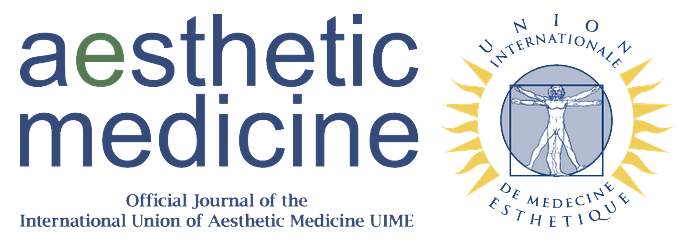Nuts and bolts of Exosomes in Aesthetic Medicine
Nuts and Bolts of Exosomes
Keywords:
Exosomes;, transport vesicles;, cosmeceuticals, regenerative medicine, wound healing, skin rejuvenationAbstract
Over the past decade, the body of knowledge about the behavior and properties of exosomes has grown exponentially, resulting in an overwhelming number of published scientific articles. Exosomes are constitutively synthesized and released by many human cells, plants, animal cells, and even bacteria. Exosomes can be derived from the patient's tissues (autologous exosomes), from other human tissues (allogenic exosomes), and plants, animals, or bacteria (xenogenic exosomes). Exosomes offer innovative treatment options in medical aesthetics, such as repairing, regenerating, and rejuvenating skin tissue, preventing and reducing scarring, regulating pigmentation, promoting hair growth, and increasing the survival of fat grafts in aesthetic treatments. However, the significant cost of production is a clear indication of the industry’s first steps in its development. Furthermore, performing these therapies in a private medical office is expensive, and the technical requirements need an in-depth analysis. The key points identified as corrupting, misleading, or confusing concepts (source, cargo, process of origin, and quantity) should be clarified. For all the above, more clinical trials need to be conducted for regulatory approval because, to our knowledge, no exosome-based products or therapies have been approved by any regulatory agency. Nonetheless, exosome treatments undoubtedly represent a breakthrough for aesthetic regenerative medicine.
References
Xiong M, Zhang Q, Hu W, et al. The novel mechanisms and applications of exosomes in dermatology and cutaneous medical aesthetics. Pharmacol Res. 2021; 166:105490.
Zhang B, Gong J, He L, et al. Exosomes based advancements for application in medical aesthetics. Front Bioeng Biotechnol. 2022; 10:1083640.
Sengupta V, Sengupta S, Lazo A, Woods P, Nolan A, Bremer N. Exosomes Derived from Bone Marrow Mesenchymal Stem Cells as Treatment for Severe COVID-19. Stem Cells Dev. 2020; 29(12):747-754.
Dai S, Wei D, Wu Z, et al. Phase I Clinical Trial of Autologous Ascites-derived Exosomes Combined With GM-CSF for Colorectal Cancer. Mol Ther. 2008; 16(4):782-790.
Besse B, Charrier M, Lapierre V, et al. Dendritic cell-derived exosomes as maintenance immunotherapy after first line chemotherapy in NSCLC. Oncoimmunology. 2016; 5(4):e1071008.
Nassar W, El-Ansary M, Sabry D, et al. Umbilical cord mesenchymal stem cells derived extracellular vesicles can safely ameliorate the progression of chronic kidney diseases. Biomater Res. 2016; 20:21.
Tan ST, Aisyah PB, Firmansyah Y, Nathasia N, Budi E, Hendrawan S. Effectiveness of Secretome from Human Umbilical Cord Mesenchymal Stem Cells in Gel (10% SM-hUCMSC Gel) for Chronic Wounds (Diabetic and Trophic Ulcer) - Phase 2 Clinical Trial. J Multidiscip Healthc. 2023; 16:1763-1777.
Moutsatsou P, Ochs J, Schmitt RH, Hewitt CJ, Hanga MP. Automation in cell and gene therapy manufacturing: from past to future. Biotechnol Lett. 2019; 41(11):1245-1253.
Brembilla NC, Vuagnat H, Boehncke WH, Krause KH, Preynat-Seauve O. Adipose-Derived Stromal Cells for Chronic Wounds: Scientific Evidence and Roadmap Toward Clinical Practice. Stem Cells Transl Med. 2023; 12(1):17-25.
Ku YC, Sulaiman HO, Anderson SR, Abtahi AR. The Potential Role of Exosomes in Aesthetic Plastic Surgery: A Review of Current Literature. Plast Reconstr Surg Glob Open. 2023; 11(6):e5051.
Gurung S, Perocheau D, Touramanidou L, Baruteau J. The exosome journey: from biogenesis to uptake and intracellular signalling. Cell Commun Signal. 2021; 19(1):47.
Asadpour A, Yahaya BH, Bicknell K, Cottrell GS, Widera D. Uncovering the gray zone: mapping the global landscape of direct-to-consumer businesses offering interventions based on secretomes, extracellular vesicles, and exosomes. Stem Cell Res Ther. 2023; 14(1):111.
Turner L. The American stem cell sell in 2021: U.S. businesses selling unlicensed and unproven stem cell interventions. Cell Stem Cell. 2021; 28(11):1891-1895.
Lener T, Gimona M, Aigner L, et al. Applying extracellular vesicles based therapeutics in clinical trials – an ISEV position paper. J Extracell Vesicles. 2015; 4:30087.
ISEV2023 Abstract Book. J Extracell Vesicles. 2023; 12(S1).
Song Y, Kim Y, Ha S, et al. The emerging role of exosomes as novel therapeutics: Biology, technologies, clinical applications, and the next. Am J Reprod Immunol. 2021; 85(2):e13329.
Kalluri R, LeBleu VS. The biology, function, and biomedical applications of exosomes. Science. 2020; 367(6478)eaau6977.
Yi YW, Lee JH, Kim SY, et al. Advances in Analysis of Biodistribution of Exosomes by Molecular Imaging. Int J Mol Sci. 2020; 21(2):665.
Zhang Y, Bi J, Huang J, Tang Y, Du S, Li P. Exosome: A Review of Its Classification, Isolation Techniques, Storage, Diagnostic and Targeted Therapy Applications. Int J Nanomedicine. 2020; 15:6917-6934.
Downloads
Published
Issue
Section
License
Copyright (c) 2024 Hernán Pinto

This work is licensed under a Creative Commons Attribution-NonCommercial 4.0 International License.
This is an Open Access article distributed under the terms of the Creative Commons Attribution License (https://creativecommons.org/licenses/by-nc/4.0) which permits unrestricted use, distribution, and reproduction in any medium, provided the original work is properly cited.
Transfer of Copyright and Permission to Reproduce Parts of Published Papers.
Authors retain the copyright for their published work. No formal permission will be required to reproduce parts (tables or illustrations) of published papers, provided the source is quoted appropriately and reproduction has no commercial intent. Reproductions with commercial intent will require written permission and payment of royalties.

This work is licensed under a Creative Commons Attribution-NonCommercial 4.0 International License.





